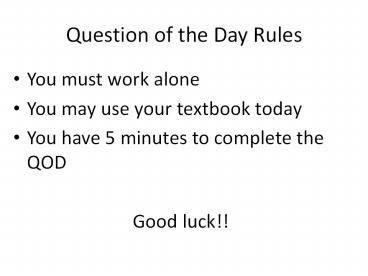Question of the Day Rules - PowerPoint PPT Presentation
1 / 28
Title:
Question of the Day Rules
Description:
Question of the Day Rules You must work alone You may use your textbook today You have 5 minutes to complete the QOD Good luck!! Questions of the Day A coalition was ... – PowerPoint PPT presentation
Number of Views:70
Avg rating:3.0/5.0
Title: Question of the Day Rules
1
Question of the Day Rules
- You must work alone
- You may use your textbook today
- You have 5 minutes to complete the QOD
- Good luck!!
2
Questions of the Day
- A coalition was formed recently to protest the
use of dihydrogen monoxide. According to the
coalition, the widespread use of this substance
has harmful effects on human health and the
environment. - What is the chemical formula for dihydrogen
monoxide? - Dihydrogen monoxide is the main component of acid
rain. Is it the solute or the solvent? Explain
your answer.
3
1) What is the chemical formula for dihydrogen
monoxide?
- Answer
- H2O
4
2) Dihydrogen monoxide is the main component of
acid rain. Is it the solute or the solvent?
Explain your answer.
- Answer
- It is the solvent because it represents the
greater part of the solution.
5
What are we doing Today?
- QOD
- Make sure A-B Lab is handed in
- Types of Chemical Changes (Ch.4)
- Dates of Tests Labs
- Class Work
- Get back Ch. 3 (ST) Test
6
Dates of Tests/Labs
- Ch. 3 EST Test, Monday, November 24
- Tutorial Thursday, November 20 after school
- Lab 31 Endothermic/Exothermic Wed, Nov 26
- Ch. 4 ST Test, Wednesday, December 3
- Tutorial Monday, December 1 after school
7
Types of Chemical Change (ST)
- We are going to learn about
- Acid-base Neutralization
- Combustion
- Cellular Respiration
- Photosynthesis
8
Indicators of chemical reactions
- Emission of light or heat
- Formation of a gas
- Formation of a precipitate
- Color change
- Emission of odor
9
Acid-Base Neutralization
- When a strong acid and a strong base solution are
mixed, a neutralization reaction occurs. In the
products, a neutral salt and water are formed.
(p.119)
10
Acid/Base Reaction
- Always in aqueous solution
- Acid (H) Base (OH-) ? Salt H2O
NaOH HCl ? NaCl H2O
NH4OH H2SO4 ? (NH4)2SO4 H2O
11
2. Combustion
Combustion or burning is a chemical reaction in
which a fuel combines with oxygen, releasing
heat. (p.121)
12
1. Combustion Reactions
- More commonly known as burning
- Easily identified (release of heat)
- For combustion 3 things need to be present
- Heat
- Fuel
- Oxygen
13
2) Combustion continued
- Three conditions must be done for combustion
reaction to happen. - Must Have Fuel
- Must have an oxidizing agent (example oxygen)
- Ignition temperature (must have a minimum
temperature to start combustion)
14
Fire Triangle
15
Combustion
- A reaction in which a compound (often carbon)
reacts with oxygen - CH4 O2 CO2 H2O
16
1. Combustion Reactions
17
- The charcoal used in a grill is basically carbon.
The carbon reacts with oxygen to yield carbon
dioxide. The chemical equation for this reaction
is C O2 ? CO2
18
Typed of Combustion
- 1) Rapid a large amount of heat light are
- produced in a short time Ex. burning of
matchstick - 2) Spontaneous occurs on its own ,without the
application of heat Ex. Forest fire, - 3) Slow Combustion over long period of time.
Released gradually into the environment Ex.
Cellular Respiration
19
What is Cellular Respiration?
20
CELLULAR RESPIRATION
C6H12O6 6O2
6CO2 6H2O energy
Process by which all organisms release energy
stored in organic molecules
21
(No Transcript)
22
- Photosynthesis is the opposite reaction to
cellular respiration (which we just looked at)!
23
Synthesis Rxns (EST)
- Also called combination reactions
- 2 elements, or compounds combine to make one
compound. - A B AB
- Na (s) Cl2 (g) NaCl (s)
- SO3 (s) H2O (l) H2SO4 (s)
- We can predict the products if they are two
elements. - Mg (s) N2 (g)
Mg3N2 (s)
24
A simulation of the reaction 2H2 O2
2H2O
25
Decomposition Rxns (EST)
- decompose fall apart
- one compound (reactant) falls apart into two or
more elements or compounds. - Usually requires energy
- AB A B
- NaCl ? Na Cl2
26
Precipitation reactions (EST)
An insoluble solid that forms during an aqueous
reaction is called a precipitate.
The calcium hydroxide reacts with carbon dioxide
to form calcium carbonate, which is insoluble in
water
Read p.118 Precipitation and look at the table
calcium hydroxide
carbon dioxide
calcium carbonate
water
Ca(OH)2
CO2
CaCO3
H2O
27
Oxidation (EST)
- It is a chemical change involving oxygen or a
substance with properties similar to those of
oxygen.
28
Classwork to do
- p. 134 of textbook
- Questions
- 17, 18, 19, 20, 21, 22, 23































